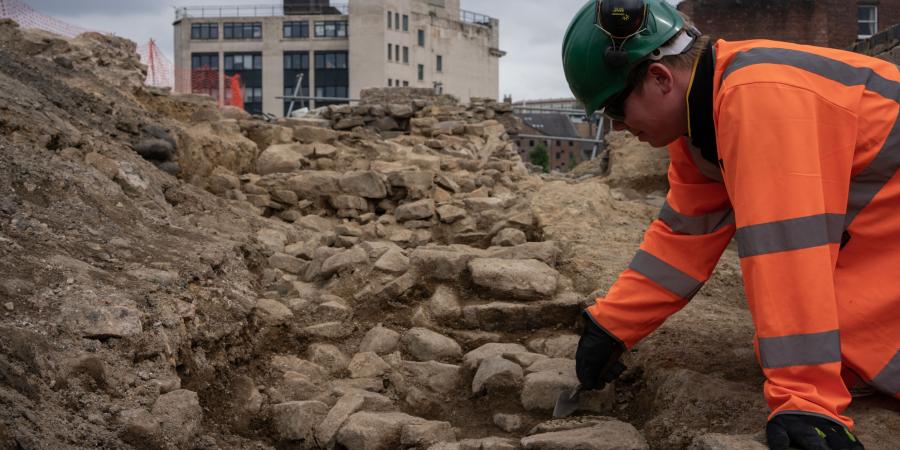Our team excavating the derelict Castle Market site for Sheffield City Council’s Castlegate regeneration project has discovered new evidence of the medieval Sheffield Castle – hailed the birthplace of Sheffield. Among the remains unearthed is the castle’s drawbridge pier - a dressed sandstone platform on which the drawbridge to the castle would have set down. This is the first time this part of the pier, a prominent feature of the castle’s gatehouse, has been uncovered.


Right: Archaeologist, Isabelle, excavates remains of the drawbridge pier © Wessex Archaeology Left: Archaeologist Ashley excavates remains of Sheffield Castle © Wessex Archaeology
While excavating the motte, the manmade defensive mound on which the castle was built, a series of internal castle walls was uncovered, with some of the walls being over 1.5 metres wide. No illustrations of the castle survive and there are only passing mentions in documents, so this is the first tangible evidence we have for the layout of the interior of the castle. Archaeomagnetic dating is being used to establish a date for the motte, and to understand the origins of this manmade mound.
Archaeologists have also excavated the six-metre-deep moat, which has revealed new insights into remains pre-dating the medieval castle, perhaps evidence from an earlier castle. Within the moat, artefacts including a mid-16th century Jetton have been found. Contemporary with Mary Queen of Scots’ imprisonment at the castle by her cousin Queen Elizabeth I, the Nuremberg copper-alloy Jetton is a counter that would have been used a bit like money.

Mid-16th century Nuremberg Jetton found at Sheffield Castle (c) Wessex Archaeology
Ashley Tuck, the archaeologist leading the dig on behalf of Wessex Archaeology, said:
“Sheffield Castle keeps revealing its secrets. As well as uncovering the impressive gatehouse and drawbridge pier, we have uncovered part of the castle’s walls that were previously unknown. These are the interior walls of the castle, adding to the picture of what this medieval power centre would have looked like during its heyday. In the moat area, new evidence has emerged, possibly relating to an undocumented earlier phase of the castle. This stands on the first page of the story of Sheffield and it is such a privilege to be part of rewriting the opener to the city’s story.”
Cllr Ben Miskell, Chair of the Transport, Regeneration and Climate Committee, said: “It’s fantastic to see the transformation of the Castlegate site really progressing towards it being an incredible public space. Working with Wessex Archaeology and Keltbray we are uncovering pieces of Sheffield’s history we never knew were there before, giving us a fantastic glimpse into how our ancestors lived and used the site. It’s been incredible to see Sheffielders being so enthusiastic about the project as well and taking every opportunity there is to get involved either through guided tours or by helping with the dig itself. The whole project is going to offer something very unique to the city in taking Sheffield right back to its beginning all those centuries ago.”
The excavation, overseen by construction engineering specialists, Keltbray, is the first large-scale professional excavation ever undertaken on the site. Once a strategic stronghold and medieval centre of power, the site was destroyed following the Civil War as a symbol of the Parliamentarian's victory. Following its demise, the site was repurposed for industry and the castle’s remains became lost to time.
Builders uncovered parts of the castle in the 1920s, then again during reconstruction works following WWII, and in 2018 Wessex Archaeology carried out trial excavation at the site which afforded glimpses of the castle’s remains. This is the first time large areas of the site have been systematically excavated using modern archaeological methods and scientific techniques.
Tim Barber, Project Director for Highwas Keltbray, said: “Keltbray is proud to be part of the work that’s taking place for Sheffield City Council at the Castlegate site. We appreciate that over many years, much of the archaeology has been covered over. The work that we’re doing together changes that and allows us to learn more about the history of Sheffield. We’re able to see how people have used this area through different periods of time and have been able to involve local people in site open tours and volunteering opportunities. We’re excited that our work in this part of Sheffield will facilitate economic growth and future development.”
Martin Gorman, Chair of the Friends of Sheffield Castle, said: “We are particularly excited to see parts of the Castle walls being uncovered as these do not appear on any old maps or documents, as well as interesting finds from the moat. We’ve had some great feedback from the volunteers that have taken part in the excavations and the tours run by Wessex Archaeology, and we very much look forward to more exciting finds as the project moves forward.”
To keep up to date with the dig visit wessexarch.co.uk/our-work/sheffield-castle or follow the action on social media @wessexarch #SheffieldCastle.
For press enquiries, please contact press@wessexarch.co.uk.
